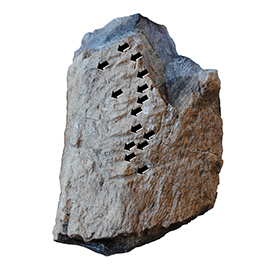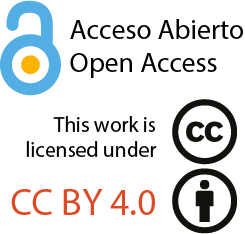A MESOZOIC DINO-FEAST: MULTIPLE TEETH MARKS ON A SAUROPOD DINOSAUR BONE FROM THE UPPER CRETACEOUS OF PATAGONIA AND EVIDENCE ON THEROPOD FEEDING BEHAVIOR
Un festín mesozoico: múltiples marcas de dientes en un hueso de dinosaurio saurópodo del Cretácio Superior de Patagonia y evidencias sobre comportamiento de alimentación de terópodos
DOI:
https://doi.org/10.5710/PEAPA.22.09.2024.512Keywords:
Teeth marks, Feeding marks, Trophic interaction, Gnaw, Cretaceous mammalAbstract
Marks left by teeth on bones are evidence for inferring trophic interactions. In carnivorous dinosaurs, such evidence is rare in the fossil record. We present here the description of a fragment of sauropod appendicular bone, which exhibits teeth marks consistent with multiple trace makers. The specimen MPM-PV-19111 comes from Cretaceous rocks outcropping at Cerro Fortaleza locality (Cerro Fortaleza Formation, Campanian–Maastrichtian), Santa Cruz Province, Argentina. It preserves three faces, two bearing grooves, and a third bearing shallow pits. There are about 100 scars (we identified at least 99 grooves and 19 pits), with the grooves mainly oriented more or less perpendicular to the main axis of the bone. These grooves have a width ranging from 1 to 3.5 mm, and generally narrow distally. The pits and punctures are circular to subcircular and variable in diameter (1.5–4 mm). The feeding traces are attributable to theropod dinosaurs -abelisaurids and megaraptorids were recorded in the same formation- of mid to large body size, notosuchid crocodyliforms, and a possible indeterminate small mammal. The teeth marks are considered post-mortem based on the lack of healing on the surrounding bone. The high number of teeth marks suggests both repeated high-power bites in a restricted area (gnawing-like behavior?) and multiple producers, probably biting the bone at different moments since smaller-sized animals would intend to avoid the larger ones. This study aims to describe and interpret the possible origin of the bite marks preserved on this Cretaceous sauropod bone.
References
Aranciaga Rolando, M., Cerroni, M., Garcia Marsá, J. A., Agnolín, F. L., Motta, M. J., Rozadilla S., Brisson Egli, F., & Novas, F. E. (2020). A new medium-sized abelisaurid (Theropoda, Dinosauria) from the late Cretaceous Allen Formation of Northern Patagonia, Argentina. Journal of South American Earth Sciences, 105, 102915.
Avilla, L. S., Fernandes, R., & Ramos, D. F. B. (2004). Bite marks on Crocodylomorph from the Upper Cretaceous of Brazil: evidence of social behavior? Journal of Vertebrate Paleontology, 24, 971–973.
Bell, P. R. & Currie, P. J. (2010). A tyrannosaur jaw bitten by a confamilial: scavenging or fatal agonism? Lethaia, 43, 278e281.
Bonaparte, J. F. (1990). New Late Cretaceous mammals from Los Alamitos Formation, Northern Patagonia. National Geographic Research 6, 63–93.
Bonaparte, J. F. & Novas, F. E. (1985). Abelisaurus comahuensis, n.g., n.sp., Carnosauria del Cretácico Tardío de Patagonia. Ameghiniana, 28, 259–265.
Botfalvai, G., Prondvai, E., & Ősi, A. (2014). Inferred bite marks on a Late Cretaceous (Santonian) bothremydid turtle and a hylaeochampsid crocodilian from Hungary. Cretaceous Research, 50, 304–317.
Boyd, C. A., Drumheller, S. K., & Gates, T. A. (2013). Crocodyliform feeding traces on juvenile Ornithischian dinosaur from the Upper Cretaceous (Campanian) Kaiparowits Formation, Utah. PloS ONE, 8(2), e57605.
Brown, C. M., Tanke, D. H., & Hone, D. W. E. (2021). Rare evidence for `gnawing-like’ behavior in a small-bodied theropod dinosaur. PeerJ, 9, e11557 http://doi.org/10.7717/peerj.11557
Brownstein, C. D. (2018). Trace fossils on dinosaur bones reveal ecosystem dynamics along the coast of eastern North America during the lastest Cretaceous. PeerJ, 6, e4973. https://doi.org/10.7717/peerj.4973
Canale J. I., Paulina-Carabajal, A., Méndez, A. H., & Lee Y. -N. (2019). New Abelisauroidea (Theropoda, Ceratosauria) remains from Cerro Fortaleza (Cerro Fortaleza Formation), Santa Cruz Province, Argentina. Reunión de Comunicaciones de la Asociación Paleontológica Argentina (Puerto Madryn 2018), Publicación Electrónica de la Asociación Paleontológica Argentina 19(1R), R6.
Carpenter, K. (1998). Evidence of predatory behavior by carnivorous dinosaurs: Gaia, 15, 135–144.
Carpenter, K. (2013). A closer look at the hypothesis of scavenging versus predation by Tyrannosaurus rex. In J. M. Parrish, R. E. Molnar, P. J. Currie, & E. B. Koppelhus (Eds.), Tyrannosaurid Paleobiology (pp. 265–277). Indiana University Press.
Carpenter, K., Sanders, F., McWhinney, L. A., & Wood, L. (2005). Evidence for predator-prey relationships: examples for Allosaurus and Stegosaurus. In K. Carpenter (Ed.), The Carnivorous Dinosaurs (pp. 325–350). Indiana University Press.
Chimento, N. R., Agnolín, F. L., & Martinelli, A. G. (2016). Mesozoic mammals from South America: implications for understanding early mammalian faunas from Gondwana. Contribuciones del MACN, 6, 199–209.
Chimento, N. R., Agnolín, F. L., García-Marsá, J., Manabe, M., Tsuihji, T., & Novas, F. E. (2024). A large therian mammal from the Late Cretaceous of South America. Scientific Reports, 14, 2854.
Chornogubsky, L. (2011). New remains of the dryolestoid mammal Leonardus cuspidatus from the Los Alamitos Formation (Late Cretaceous, Argentina). Palaeontologische Zeitschrift, 85, 434–450.
Chure, D. J., Fiorillo, A. R., & Jacobsen, A. (1998). Prey bone utilization by predatory dinosaurs in the Late Jurassic of North America, with comments on prey bone use by dinosaurs throughout the Mesozoic. Gaia, 15, 227–232.
Coria, R. A. (2001). A new theropod from the Late Cretaceous of Patagonia. In D. H. Tanke & K. Carpenter (Eds.), Mesozoic Vertebrate Life (pp. 3–9). Indiana University Press.
Dalman, S. G. & Lucas, S. G. (2018). New evidence for predatory behavior in tyrannosaurid dinosaurs from the Kirkland Formation (Late Cretaceous, Campanian), Northwestern New Mexico. New Mexico Museum of Natural History and Sciences Bulletin, 79, 113–124.
Dalman, S. G. & Lucas, S. G. (2021). New evidence for cannibalism in tyrannosaurid dinosaurs from the Upper Cretaceous (Campanian/Maastrichtian) San Juan Basin of New Mexico. New Mexico Museum of Natural History and Science Bulletin, 82, 39–56.
D’Amore, D. C. & Blumenschine, R. J. (2009). Komodo monitor (Varanus komodoensis) feeding behavior and dental function reflected through tooth marks on bone surfaces, and the application to ziphodont paleobiology. Paleobiology, 35, 525–552.
de Valais, S., Apesteguía, S., & Garrido, A. C. (2012). Cretaceous small scavengers: feeding traces in tetrapod bones from Patagonia, Argentina. PLoS ONE, 7(1), e29841.
Drumheller, S. K. & Brochu, C. A. (2014). A diagnosis of Alligator mississippiensis bite marks with comparisons to existing crocodylian datasets. Ichnos, 21, 131–146.
Drumheller, S. K., McHugh, J. B., Kane, M., Riedel, A., & D’Amore, D.C. (2020). High frequencies of theropod bite marks provide evidence for feeding, scavenging, and possible cannibalism in a stressed Late Jurassic ecosystem. PLoS ONE, 15(5), e0233115.
Erickson, G. M. & Olson, K. H. (1996). Bite marks attributable to Tyrannosaurus rex: preliminary description and implications. Journal of Vertebrate Paleontology, 16, 175–178.
Evans, S. E. (1983). Mandibular fracture and inferred behaviour in a fossil reptile. Copeia, 3, 845–847.
Ezcurra, M. D., Agnolín, F. L., & Novas, F. E. (2010). An abelisauroid dinosaur with a non-atrophied manus from the Late Cretaceous Pari Aike Formation of South Patagonia. Zootaxa, 2450, 1–25.
Farlow, J. O. & Holtz, T. R. (2001). The fossil record of predation in dinosaurs. Paleontological Society Papers, 8, 251–266.
Filippi, L. S. & Bellardini, F. (2021). Feeding traces on postcranial sauropod remains from Bajo de la Carpa Formation (Upper Cretaceous, Santonian), northern Neuquén Basin, Patagonia, Argentina. Cretaceous Research, 119, 104696.
Fiorillo, A. R. (1991). Prey bone utilization by predatory dinosaurs. Palaeogeography, Palaeoclimatology, Palaeoecology, 88, 157e166. https://doi.org/10.1016/0031-0182(91)90062-v
Gianechini, F. & de Valais, S. (2015). Bioerosion trace fossils on bones of the Cretaceous South American theropod Buitreraptor gonzalezorum Makovicky, Apesteguía and Agnolín, 2005 (Deinonychosauria). Historical Biology, 28(4), 533–549. https://doi.org/10.1080/08912963.2014.991726
Gignac, P. M., Makovicky, P. J., Erickson, G. M., & Walsh, R. P. (2010). A description of Deinonychus antirrhopus bite marks and estimates of bite force using tooth indentation simulations. Journal of Vertebrate Paleontology, 30, 1169–1177.
Goin, F. J., Martinelli, A. G., Soto-Acuña, S., Vieytes, E., Manríquez L. M. E., Fernández, R. A., Pino, J. P., Trevisan, C., Kaluza, J., Reguero, M. A., Leppe, M., Ortiz H., Rubilar-Rogers, D., & Vargas, A. O. (2020). First Mesozoic mammal from Chile: the southernmost record of a Late Cretaceous gondwanatherian. Boletin del Museo Nacional de Historia Natural, Chile, 69, 5–31.
Gomes da Costa Pereira, P.V. L., Pedro Bogado, J., Baptista Ribeiro, T., Paiva Belfort, L., de Valais, S., & Roberto dos Anjos Candeiro, C. (2022). Dino on the menu: tooth traces in a sauropod epiphysis from the Presidente Prudente Formation (CampanianMaastrichtian), Bauru Group, Brazil-palaeobiological and palaeoecological implications. Historical Biology, 34(11), 2079–2088.
Grillo, O. N. & Delcourt, R. (2016). Allometry and body length of abelisauroid theropods: Pycnonemosaurus nevesi is the new king. Cretaceous Research, 69, 71–89.
Holtz, T. R. (2003). Dinosaur predation: evidence and ecomorphology. In P. H. Kelley, M. Kowalewski, & T. A. Hansen (Eds.), Predator-Prey Interactions in the Fossil Record (pp. 325–340). Springer.
Holtz, T. R. (2008). A critical reappraisal of the obligate scavenging hypothesis for Tyrannosaurus rex and other tyrant dinosaurs. In P. Larson & K. Carpenter (Eds.), Tyrannosaurus rex: The Tyrant King (pp. 370–396). Bloomington: Indiana University Press.
Hone, D. W. E. & Chure, D. J. (2018). Difficulties in assigning trace makers from theropodan bite marks: an example from a young diplodocoid sauropod. Lethaia, 51, 456e466. https://doi.org/10.1111/let.12267
Hone, D. W. E. & Rauhut, O. W. (2010). Feeding behavior and bone utilization by theropod dinosaurs. Lethaia, 43, 232–244.
Hone, D. W. E. & Tanke, D. H. (2015). Pre-and postmortem tyrannosaurid bite marks on the remains of Daspletosaurus (Tyrannosaurinae: Theropoda) from Dinosaur Provincial Park, Alberta, Canada. PeerJ, 3, e885. https://doi.org/10.7717/peerj.885
Hone, D. W. E. & Watabe, M. (2010). New information on scavenging and selective feeding behaviour of tyrannosaurids. Acta Palaeontologica Polonica, 55, 627–634.
Hone, D. W. E., Tanke, D. H., & Brown, C. M. (2018). Bite marks on the frill of a juvenile Centrosaurus from the Late Cretaceous Dinosaur Provincial Park Formation, Alberta, Canada. PeerJ, 6, e5748. https://doi.org/10.7717/peerj.5748
Hone, D. W. E., Tsuhiji, T., Watabe, M., & Tsogbataar, K. (2012). Pterosaurs as a food source for small dromaeosaurs. Palaeogeography, Palaeoclimatology, Palaeoecology, 331, 27–30.
Hu, Y., Meng, J., Wang, Y., & Li, C. (2005). Large Mesozoic mammals fed on young dinosaurs. Nature, 433, 149–152.
Jacobsen, A. R. (1998). Feeding behaviour of carnivorous dinosaurs as determined by tooth marks on dinosaur bones. Historical Biology, 23, 17–26.
Kane, A., Healy, K., Ruxton, G. D., & Jackson, A. L. (2016). Body size as a driver of scavenging in theropod dinosaurs. American Naturalist, 187, 706–716.
Kane, A., Healey, K., & Ruxton G. D. (2023). Was Allosaurus really predominantly a scavenger? Ecological Modelling, 476, 110247. https://doi.org/10.1016/j.ecolmodel.2022.110247
King, J. L., Mchugh, J. B., Wedel, M. J., & Curtice, B. (2024). A previously unreported form of dorsal rib pneumaticity in Apatosaurus (Dinosauria: Sauropoda) and its implication for pneumatic variation among diplodocid dorsal ribs. Journal of Vertebrate Paleontology. 43(5). https://doi.org/10.1080/02724634.2024.2316665
Lacovara, K. J., Ibiricu, L., Lamanna, M. C., Poole, J. C., Schroeter, E. R., Ullmann, P. V., Voegele, K. K., Boles, Z. M., Egerton, V. M., Harris, J. D., Martínez, R. D., & Novas, F. E. (2014). A gigantic, exceptionally complete titanosaurian sauropod dinosaur from Southern Patagonia, Argentina. Scientific Reports, 4, 6196. https://doi.org/10.1038/srep06196
Lei, R., Tschopp, E., Hendrickx, C., Wedel, M. J., Norell, M., & Hone, D. W. E. (2023). Bite and tooth marks on sauropod dinosaurs from the Morrison Formation. PeerJ, 11, e16327. http://doi.org/10.7717/peerj.16327
Longrich, N. R. & Ryan, M. J. (2010). Mammalian tooth marks on the bones of dinosaurs and other late Cretaceous vertebrates. Palaeontology, 53, 703–709.
Longrich, N. R., Horner, J. R., Erickson, G. M., & Currie, P. J. (2010). Cannibalism in Tyrannosaurus rex. PLoS ONE 5(10), e13419. https://doi.org/10.1371/journal.pone.0013419
Martinelli, A. G., Soto-Acuña, S., Goin, F. J., Kaluza, J., Bostelmann, J. E., Fonseca, P. H., Reguero, M. A., Leppe, M., & Vargas, A. O. (2021). New cladotherian mammal from southern Chile and the evolution of mesungulatid meridiolestidans at the dusk of the Mesozoic era. Scientific Reports, 11, 7594. https://doi.org/10.1038/s41598-021-87245-4
Maor, R., Dayan, T., Ferguson-Gow, H., & Jones, K. E. (2017). Temporal niche expansion in mammals from a nocturnal ancestor after dinosaur extinction. Nature Ecology and Evolution, 1, 1889–1895.
Njau, J. K. & Blumenschine, R. J. (2006) A diagnosis of crocodile feeding traces on larger mammal bone, with fossil examples from the Plio-Pleistocene Olduvai Basin, Tanzania. Journal of Human Evolution, 50, 142–162.
Noto, C. R., Main, D. J., & Drumheller, S. K. (2012). Feeding traces and paleobiology of a Cretaceous (Cenomanian) crocodyliform: example from the Woodbine Formation of Texas. Palaios, 27, 105–115.
Novas, F. E., Cambiaso, A. V., & Ambrioso, A. A. (2004). New basal iguanodontian (Dinosauria, Ornithischia) from the Upper Cretaceous of Patagonia. Ameghiniana, 41, 75–82.
Novas, F. E., Salgado, L., Calvo, J., & Agnolin, F. (2005). Giant titanosaur (Dinosauria, Sauropoda) from the Late Cretaceous of Patagonia. Revista del Museo Argentino de Ciencias Naturales, 7, 37–41.
Novas, F. E., Ezcurra, M. D., & Lecuona, A. (2008a). Orkoraptor burkei nov. gen. et sp., a large theropod from the Maastrichtian Pari Aike Formation, Southern Patagonia, Argentina. Cretaceous Research, 29(3), 468-480. https://doi.org/10.1016/j.cretres.2008.01.001
Novas, F. E., Pol, D., Canale, J. I., Porfiri, D., & Calvo, J. O. (2008b). A bizarre Cretaceous theropod dinosaur from Patagonia and the evolution of Gondwanan dromaeosaurids. Proceedings of the Royal Society B, 276, 1101–1107.
Novas, A., Agnolín, F. L., Rozadilla, S., Aranciaga-Rolando, A., Brisson-Egli, F., Motta, M. J., Cerroni, M., Ezcurra, M. D., Martinelli, A., D’Angelo, J., Alvarez-Herrera, G., Gentil, A. R., Bogan, S., Chimento, N. R., García-Marsá, A., Lo Coco, G., Miquel, S. E., Brito, F., Vera, E. I., Perez Loinaze, V., Fernández, M. S., & Salgado, L. (2019). Paleontological discoveries in the Chorrillo Formation (upper Campanian-lower Maastrichtian, Upper Cretaceous), Santa Cruz Province, Patagonia, Argentina. Revista del Museo Argentino de Ciencias Naturales, 21, 217–293.
Pahl, C. C. & Ruedas, L. A. (2021). Carnosaurs as apex scavengers: agent-based simulations reveal possible vulture analogues in late Jurassic dinosaurs. Ecological Modelling, 458, 109706. https://doi.org/10.1016/j.ecolmodel.2021.109706
Paik, I. -S., Kim, H. -J., Lim, J. D., Huh, M., & Lee H. I. (2011). Diverse tooth marks on an adult sauropod bone bone from the Early Cretaceous, Korea: Implications in feeding behaviour of theropod dinosaurs. Palaeogeography, Palaeoclimatology, Palaeoecology, 309, 342–346.
Paulina-Carabajal, A., Barrios, F. T., Méndez, A. H., Cerda, I. A., & Lee, Y-N. (2021) A Late Cretaceous dinosaur and crocodyliform faunal association–based on isolate teeth and osteoderms–at Cerro Fortaleza Formation (Campanian–Maastrichtian) type locality, Santa Cruz, Argentina. PLoS ONE 16(9), e0256233. https://doi.org/10.1371/journal.pone.0256233
Pirrone, C. A., Buatois, L. A., & Bromley R. G. (2014). Ichnotaxobases for bioerotion trace fossils in bones. Journal of Paleontology, 88, 195–203.
Pobiner, B. (2008). Paleoecological information in predator tooth marks. Journal of Taphonomy 6(3e4), 373–397.
Pujos, F. & Salas-Gismondi, R. (2020). Predation of the giant Micoene caiman Purussaurus on a mylodontid ground sloth in the wetlands of proto-Amazonia. Biology Letters, 16, 20200239. http://dx.doi.org/10.1098/rsbl.2020.0239
Rivera-Sylva, H. E., Hone, D. W. E., & Dodson, P. (2012). Bite marks of a large theropods on an hadrosaur limb bone from Coahuila, Mexico. Boletín de la Sociedad Geológica Mexicana, 64, 155–159.
Robinson, R. F., Jasinski, S. E., & Sullivan, R. M. (2015). Theropod bite marks on dinosaur bones: indications of a scavenger, predator or both? and their taphonomic implications. New Mexico Museum of Natural History and Science Bulletin, 68, 275–282.
Rogers. R. R., Krause, D. W., & Curry Rogers, K. (2003). Cannibalism in the Madagascan dinosaur Majungatholus atopus. Nature, 422, 515–518.
Rothschild, B. M. (2014). Unexpected behavior in the Cretaceous: tooth-marked bones attributable to tyrannosaur play. Ethology Ecology and Evolution, 27, 1–10.
Sadlok, G. (2022). Carnivorous reptile feeding strategies and postmortem food-processing behaviors: tooth traces on bones from the Upper Triassic Grabowa Formation (southern Poland). Journal of Paleontology, 96(5), 1189–1208.
Schwimmer, D. R. (2010). Bite marks of the giant crocodylian Deinosuchus on Late Cretaceous (Campanian) bones. In M. J. Lucas, S. G. Lockley, & J. A. Spielmann (Eds.), Crocodyle tracks and traces (pp. 183–190). New Mexico Museum of Natural History and Sciences, Bulletin 51.
Sickmann, Z. T, Schwartz, T. M., & Graham, S. A. (2018). Refining stratigraphy and tectonic history using detrital zircon maximum depositional age: An example from the Cerro Fortaleza Formation, Austral Basin, southern Patagonia. Basin Research, 30, 708–729.
Tanke, D. H. & Currie, P. J. (1998). Head-biting behavior in theropod dinosaurs: Paleopathological evidence. Gaia, 15, 167–184.
Tettamanti, C., Moyano Paz, D., Varela, A. N., Tineo D. E., GómezPeral, L. E., Poiré, D., Cereceda, A., & Odino Barreto, A. L. (2018). Sedimentology and fluvial styles of the Uppermost Cretaceous Continental Deposits of the Austral-Magallanes Basin, Patagonia, Argentina. Latin American Journal of Sedimentology and Basin Analysis, 25, 149–168.

Additional Files
Published
Issue
Section
License
Copyright (c) 2025 Ariana Paulina-Carabajal, Ariel Hernán Méndez, Karen Ulloa-Guaiquín, Facundo Irazoqui, Yuong-Nam Lee

This work is licensed under a Creative Commons Attribution-NoDerivatives 4.0 International License.
Authors retain copyright and grant the journal right of first publication with the work simultaneously licensed under a Atribución/Reconocimiento 4.0 Internacional that allows others to share the work with an acknowledgement of the work's authorship and initial publication in this journal.















